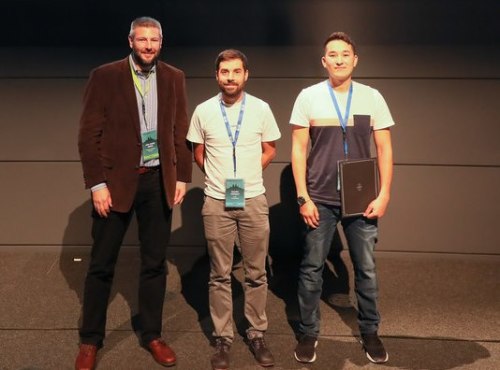Poster award for HZB PhD student

John Uhlrich, Editor-in-Chief at Wiley VCH presented an award to Quentin Jeangros, EPFL, and Eike Köhnen, HZB, for their outstanding posters (from left to right). © Gruppe Steve Albrecht/HZB
Eike Köhnen received an award for his poster on perovskite silicon tandem cells at the 4th International Conference on Perovskite Solar Cells and Optoelectronics (PSCO) in Lausanne, Switzerland. He is a PhD student in the Junior Research Group on Perovskite Tandem Cells led by Dr. Steve Albrecht.
Tandem cells made of organometallic perovskite layers and silicon have the potential for very high efficiencies. While perovskites in particular convert blue parts of the light spectrum into electrical energy, silicon uses the red parts of the light. Eike Köhnen is working on the design of a so-called monolithic tandem cell.
For his poster, which he presented at the 4th International Conference on Perovskite Solar Cells and Optoelectronics (PSCO) in Lausanne, Switzerland, he received an award sponsored by Wiley Science Publishers.
Köhnen has realized a highly efficient monolithic tandem solar cell with an efficiency of 25 percent, which has also been certified by independent bodies. The tandem cell was manufactured at HZB, the silicon cell being produced at HZB-Institute PVcomB and the perovskite cell at HySPRINT. By optimizing the optical and electrical properties of the tandem-top contact, it was even possible to achieve an efficiency of 26 percent, which is the highest efficiency currently published in the literature for this tandem architecture. Since the spectrum arriving on Earth changes over the course of the day, Köhnen also investigated the influence of the spectrum on the behavior of the tandem solar cell.
arö
https://www.helmholtz-berlin.de/pubbin/news_seite?nid=14951;sprache=en
- Copy link
-
The twisted nanotubes that tell a story
In collaboration with scientists in Germany, EPFL researchers have demonstrated that the spiral geometry of tiny, twisted magnetic tubes can be leveraged to transmit data based on quasiparticles called magnons, rather than electrons.
-
Ernst Eckhard Koch Prize and Innovation Award on Synchrotron Radiation 2025
At the 27th BESSY@HZB User Meeting, the Friends of HZB honoured the dissertation of Dr Enggar Pramanto Wibowo (Friedrich-Alexander University Erlangen-Nuremberg). The Innovation Award on Synchrotron Radiation 2025 went to Prof. Tim Salditt (Georg-August-University Göttingen) and Professors Danny D. Jonigk and Maximilian Ackermann (both, University Hospital of RWTH Aachen University).
-
Bright prospects for tin perovskite solar cells
Perovskite solar cells are widely regarded as the next generation photovoltaic technology. However, they are not yet stable enough in the long term for widespread commercial use. One reason for this is migrating ions, which cause degradation of the semiconducting material over time. A team from HZB and the University of Potsdam has now investigated the ion density in four different, widely used perovskite compounds and discovered significant differences. Tin perovskite semiconductors produced with an alternative solvent had a particular low ion density — only one tenth that of lead perovskite semiconductors. This suggests that tin-based perovskites could be used to make solar cells that are not only really environmentally friendly but also very stable.
